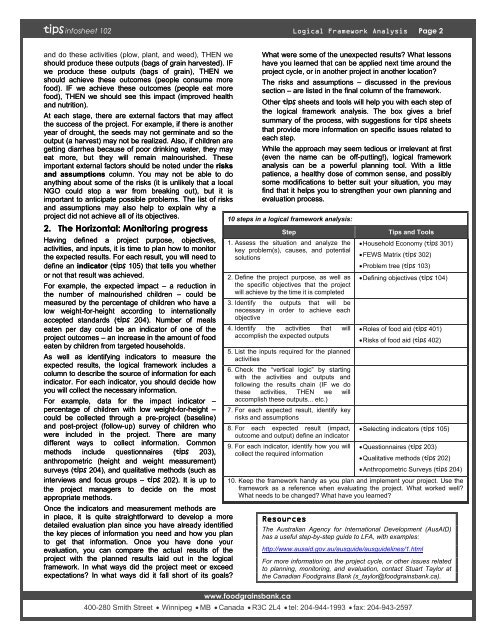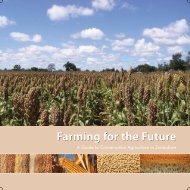tips 102 - Canadian Foodgrains Bank
tips 102 - Canadian Foodgrains Bank
tips 102 - Canadian Foodgrains Bank
You also want an ePaper? Increase the reach of your titles
YUMPU automatically turns print PDFs into web optimized ePapers that Google loves.
<strong>tips</strong> infosheet <strong>102</strong> Logical Framework Analysis Page 2<br />
and do these activities (plow, plant, and weed), THEN we<br />
should produce these outputs (bags of grain harvested). IF<br />
we produce these outputs (bags of grain), THEN we<br />
What were some of the unexpected results What lessons<br />
have you learned that can be applied next time around the<br />
project cycle, or in another project in another location<br />
should achieve these outcomes (people consume more<br />
The risks and assumptions – discussed in the previous<br />
food). IF we achieve these outcomes (people eat more<br />
section – are listed in the final column of the framework.<br />
food), THEN we should see this impact (improved health<br />
and nutrition).<br />
Other <strong>tips</strong> sheets and tools will help you with each step of<br />
the logical framework analysis. The box gives a brief<br />
At each stage, there are external factors that may affect<br />
summary of the process, with suggestions for <strong>tips</strong> sheets<br />
the success of the project. For example, if there is another<br />
year of drought, the seeds may not germinate and so the<br />
that provide more information on specific issues related to<br />
output (a harvest) may not be realized. Also, if children are<br />
each step.<br />
getting diarrhea because of poor drinking water, they may<br />
eat more, but they will remain malnourished. These<br />
important external factors should be noted under the risks<br />
and assumptions column. You may not be able to do<br />
anything about some of the risks (it is unlikely that a local<br />
NGO could stop a war from breaking out), but it is<br />
important to anticipate possible problems. The list of risks<br />
While the approach may seem tedious or irrelevant at first<br />
(even the name can be off-putting!), logical framework<br />
analysis can be a powerful planning tool. With a little<br />
patience, a healthy dose of common sense, and possibly<br />
some modifications to better suit your situation, you may<br />
find that it helps you to strengthen your own planning and<br />
evaluation process.<br />
and assumptions may also help to explain why a<br />
project did not achieve all of its objectives.<br />
2. The Horizontal: Monitoring progress<br />
10 steps in a logical framework analysis:<br />
Step<br />
Tips and Tools<br />
Having defined a project purpose, objectives, 1. Assess the situation and analyze the • Household Economy (<strong>tips</strong> 301)<br />
activities, and inputs, it is time to plan how to monitor key problem(s), causes, and potential<br />
the expected results. For each result, you will need to solutions<br />
• FEWS Matrix (<strong>tips</strong> 302)<br />
define an indicator (<strong>tips</strong> 105) that tells you whether<br />
or not that result was achieved.<br />
2. Define the project purpose, as well as<br />
• Problem tree (<strong>tips</strong> 103)<br />
• Defining objectives (<strong>tips</strong> 104)<br />
For example, the expected impact – a reduction in the specific objectives that the project<br />
the number of malnourished children – could be will achieve by the time it is completed<br />
measured by the percentage of children who have a 3. Identify the outputs that will be<br />
low weight-for-height according to internationally<br />
accepted standards (<strong>tips</strong> 204). Number of meals<br />
necessary in order to achieve each<br />
objective<br />
eaten per day could be an indicator of one of the 4. Identify the activities that will • Roles of food aid (<strong>tips</strong> 401)<br />
project outcomes – an increase in the amount of food accomplish the expected outputs<br />
• Risks of food aid (<strong>tips</strong> 402)<br />
eaten by children from targeted households.<br />
5. List the inputs required for the planned<br />
As well as identifying indicators to measure the activities<br />
expected results, the logical framework includes a<br />
6. Check the “vertical logic” by starting<br />
column to describe the source of information for each<br />
with the activities and outputs and<br />
indicator. For each indicator, you should decide how following the results chain (IF we do<br />
you will collect the necessary information.<br />
these activities, THEN we will<br />
For example, data for the impact indicator –<br />
percentage of children with low weight-for-height –<br />
could be collected through a pre-project (baseline)<br />
accomplish these outputs... etc.)<br />
7. For each expected result, identify key<br />
risks and assumptions<br />
and post-project (follow-up) survey of children who 8. For each expected result (impact,<br />
were included in the project. There are many outcome and output) define an indicator<br />
• Selecting indicators (<strong>tips</strong> 105)<br />
different ways to collect information. Common<br />
9. For each indicator, identify how you will • Questionnaires (<strong>tips</strong> 203)<br />
methods include questionnaires (<strong>tips</strong> 203), collect the required information<br />
• Qualitative methods (<strong>tips</strong> 202)<br />
anthropometric (height and weight measurement)<br />
surveys (<strong>tips</strong> 204), and qualitative methods (such as<br />
interviews and focus groups – <strong>tips</strong> 202). It is up to<br />
• Anthropometric Surveys (<strong>tips</strong> 204)<br />
10. Keep the framework handy as you plan and implement your project. Use the<br />
the project managers to decide on the most framework as a reference when evaluating the project. What worked well<br />
appropriate methods.<br />
What needs to be changed What have you learned<br />
Once the indicators and measurement methods are<br />
in place, it is quite straightforward to develop a more<br />
detailed evaluation plan since you have already identified<br />
the key pieces of information you need and how you plan<br />
to get that information. Once you have done your<br />
evaluation, you can compare the actual results of the<br />
project with the planned results laid out in the logical<br />
framework. In what ways did the project meet or exceed<br />
expectations In what ways did it fall short of its goals<br />
Resources<br />
www.foodgrainsbank.ca<br />
The Australian Agency for International Development (AusAID)<br />
has a useful step-by-step guide to LFA, with examples:<br />
http://www.ausaid.gov.au/ausguide/ausguidelines/1.html<br />
For more information on the project cycle, or other issues related<br />
to planning, monitoring, and evaluation, contact Stuart Taylor at<br />
the <strong>Canadian</strong> <strong>Foodgrains</strong> <strong>Bank</strong> (s_taylor@foodgrainsbank.ca).<br />
400-280 Smith Street • Winnipeg • MB • Canada • R3C 2L4 • tel: 204-944-1993 • fax: 204-943-2597
















